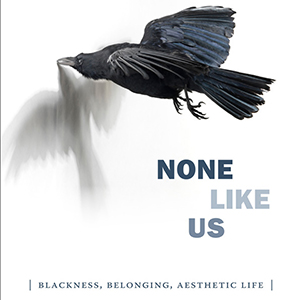The Best of None Like Us

Professor Stephen Best’s book chat about None Like Us: Blackness, Belonging, Aesthetic Life (2018) began with a simple question: “Why did you write this book?” Best’s response to this question identified one of his work’s central purposes — challenging common constructions of blackness by proposing a new critical approach to African American literary and cultural studies. “The thing that has become a point of interest is the way that the archive itself is an enactment of violence and exclusions,” said Best. Instead, he proposed, “I wanted to interrogate the way in our work that we are performing our blackness.”
Best’s talk was part of the Townsend Center for the Humanities’ book chat series. Speaking in conversation with Professor Damon Young of the French and Film & Media departments, Best discussed his book None Like Us, which appears in the Duke University Press series Theory Q. Young introduced None Like Us as a text that is focused on both unsettling and working through “what blackness is, what is its relation to the history of slavery is, and if blackness is a collective identity.”
The conversation quickly turned to critical conceptions of blackness. Best identified four popular critical foundations to African American studies: (1) the idea of the middle passage as a “founding” of American blackness, (2) the conception that African Americans “inherit” a subjectivity from these instances of violence, (3) the positioning of this inheritance as the beginning of African American community, and (4) the extent to which scholars come to possess an identity in recovering these lives, which are missing from the archive. Best clarified that African American studies is not the only field that works with a limited or “impoverished” archive. However, he proposed that scholars of color within African American studies adopt a specific critical attitude of “melancholic historicism.”
But Best does not wholly reject existing conceptions of black identity. Instead, he works to unsettle and complicate our understanding of what may constitute blackness. During the chat, Young drew the audience's attention to the opening sentence of None Like Us’s second chapter: “It passes for an unassailable truth that the slave past provides an explanatory prism for understanding the black political present.” Best specified that he does not write to negate this idea, but instead to try to create the conditions for asking the question, “Why do we believe the slave trade is the founding of American black identity?”
Best questioned such critical conventions throughout the book chat, describing his attempts to “formulate a cross, a range of materials — from contemporary art to my trips to the archive.” None Like Us is divided into four distinct sections which address different historical or artistic moments: a philosophical examination of the artworks of Mark Bradford and El Anatsui, a close reading of Toni Morrison’s novels, an exploration of the phenomenon of slave suicide, and a critical examination of the role of rumor in the achive. Best analyzes Toni Morrison’s novels Beloved and A Mercy as works that propose potential sites of formation for blackness; in another section, he discusses Mark Bradford’s contemporary artwork at SFMOMA. Best spoke about the experience of working with visual art, suggesting that one can “read” a physical, canvas surface as a literary project.
These artistic representations of layered and textured experiences may reflect what Best identified as the “intergenerational short circuits” of blackness. As he does in the opening chapter of None Like Us, Best compared his relationship with his father to James Baldwin’s relationship with his stepfather. He noted that Baldwin felt that his stepfather despised the fact that his children embraced a world that could not embrace him — much like Best’s own entrance into the world of academia was the cause of both pride and estrangement in his relationship with his own father. Ultimately, Best proposed that short circuits between generations create a “structure of non-identity,” especially within black identity. He suggested that we must envision a world in which the identity categories that we use today no longer exist, creating a world of people who are, to quote Richard Thomas Ford, “our heirs but not our descendants.”
Much like the chapters of None Like Us, Best’s remarks focused on uncovering and exploring new ways of engaging blackness and the past. Seeking freedom from constraining conceptions of blackness, tradition, diasporic kinship, and historical inheritance, Best envisions a new relation to the past, “a structure in which it becomes possible for us to acknowledge that sometimes the past’s purpose is to withdraw from purpose.”